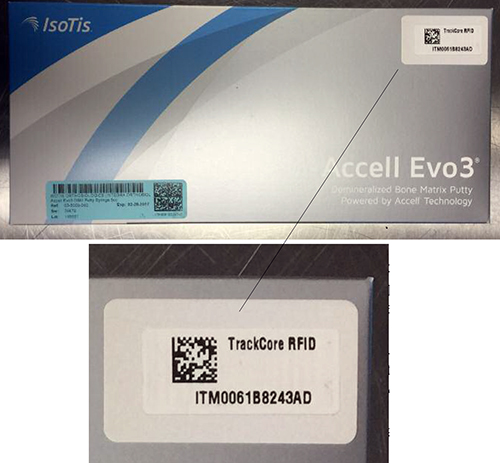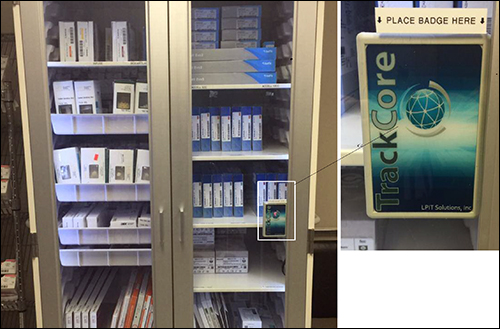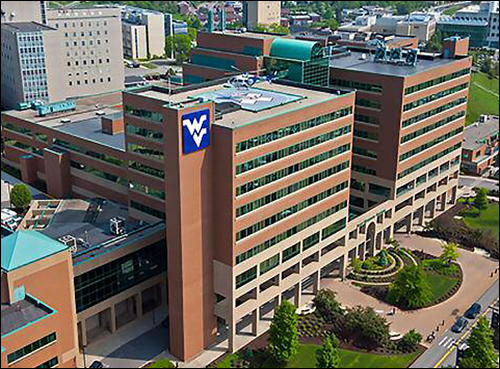Jun 23, 2016For 10 years, some hospitals have been using bar codes and TrackCore Operating Room software to monitor biologic tissues and surgical implants, to comply with safety standards established by the U.S. Food and Drug Administration (FDA) and The Joint Commission, the not-for-profit organization that accredits hospitals. But the manual process is laborious and often an afterthought for nurses, whose first priority is hands-on patient care, says Alan Brander, TrackCore's VP of national sales and a former chief nursing officer for a regional hospital. "Skipping steps in the interest of time jeopardizes compliance," he says.
The software is designed to integrate with patient electronic health records (EHR) and materials-management systems (MMS). But when tissues or implants are recalled, it's still cumbersome to locate items that must be removed from inventory and identify patients who have received the recalled items. "When there are issues with the chain of custody and inventory accuracy, there can be compliance issues," Brander says.
Hospital directors of surgery asked TrackCore for an automated, "touchless" workflow for tissue tracking, says Ross MacGregor, TrackCore's director of strategic accounts and new business development. So in 2013, the software company began researching technology solutions and storage options.
"We performed various customer workflow studies and realized that TrackCore software without RFID required nurses to record product movement in and out of storage, which still took a considerable amount of time," Brander says. "Using RFID technology would eliminate the need for nurses to log movement and provide real-time inventory visibility, automated temperature monitoring and nursing accountability and further workflow efficiencies to streamline the process for tissue and implant tracking."
TrackCore decided to integrate its software with RFID-enabled storage units. "RFID was a relatively new, yet building, technology in the health-care space," says James Casavant, TrackCore's CTO. "As we saw the technology maturing, its use became more viable for our needs, and at the same time, the cost of the technology began to fall, making it more affordable for our customers." Terso Solutions, which provides RFID-enabled cabinets, refrigerators and freezers to hospitals, had the technology and storage units TrackCore needed to meet customer demand.
TrackCore and Terso formed a partnership that resulted in the creation of TrackCore Operating Room With Integrated RFID Enclosures, launched in September 2014. To date, more than 30 U.S. hospitals have adopted the RFID solution, with many more existing customers preparing budgeting groundwork for the upgrade, MacGregor says. In addition to meeting the original goal of facilitating an automated workflow, he notes, hospitals that have deployed the solution are saving money, reducing errors and improving patient care.
West Virginia University Ruby Memorial Hospital, a 500-plus-bed facility with a Level 1 trauma center designation, upgraded to TrackCore RFID in 2015. "In a trauma center, people do not always go through the protocols we have in place," says Kimberly Cheuvront, Ruby Memorial's quality assurance coordinator of perioperative services. "There was a lot of follow-up to ID who the patient was, who received the implant." It was a situation that required paper chasing and time from nurses.
"We've seen a lot of savings in waste [costs]," Cheuvront says. "We are able to monitor product expiration dates. We can also track trends in usage by the surgeons. There are some items they stop using because they prefer something else." Error rates tracking products that were implanted in patients during procedures dropped from 3 percent to lower than 1 percent, she adds.
Developing a Complete Solution
It took approximately one year to integrate TrackCore's web-based software with Terso's RFID-enabled storage units. The two companies established a crossfunctional team that included software developers, RFID experts, integration specialists, clinical nurses, sales personnel and trainers.

The team members defined how the software and storage units would interact to provide a seamless workflow for hospitals. They also collaborated on how to install and operate the solution at hospitals. Then they tested all use cases at both hospital staff and patient levels to ensure the integrated solution met all compliance and safety requirements.
TrackCore RFID is designed to automatically track tissue and implants from initial receipt at hospitals to final disposition (whether implanted, disposed of during a procedure or shipped back to the manufacturer). Individual boxes of biologic tissues (such as bones, ligaments and skin), nonbiologic implants (medical devices, orthopedics and synthetics), and hardware (plates, rods and screws) are identified with Avery Dennison EPC Gen 2 passive ultrahigh-frequency RFID tags made with Impinj Monza 5 and R6 chips. Some items in foil packaging require flag tags, which use the same types of chips.
TrackCore prints the RFID labels and provides them to hospitals. Hospital personnel apply a label to each box of tissue or implants (only some manufacturers RFID-tag these products before shipping), and then scan the label and product bar code to associate the tag's unique identification number with the product in TrackCore's system. The product information includes name, part number, lot and serial number, and expiration date. "We then print a blue label that includes the RFID tag ID number and all the product info," says Jason Merrill, materials and business manager surgical services at St. Dominic Hospital in Jackson, Miss. The 535-bed acute-care facility adopted TrackCore's RFID solution in early 2015.
The Terso cabinets, refrigerators and freezers, available in a variety of sizes, are equipped with Impinj Speedway Revolution readers. The storage units also have low-frequency proximity readers for access control. Designated hospital personnel are issued access badges.
TrackCore provides the first 500 tags and 50 access badges, which are reusable, with implementations of up to five storage units; larger orders include more tags and badges. Hospitals order additional tags as needed. Each tags costs $1, but prices continue to fall, MacGregor says.
Automating Workflow
When tagged items are placed in the storage units, the readers capture the tag ID numbers and transmit the data, via a wireless LAN, or cellular or Wi-Fi connection, to Terso's cloud-based Jetstream platform. The TrackCore RFID system pulls real-time data from the Jetstream servers.
When an authorized user opens an RFID cabinet and removes tagged items for a patient, the system reads the items and transmits the information, including who accessed the cabinet, to the Jetstream servers. Users note in the TrackCore system whether an item was expired, used or disposed of during a procedure. The software updates the "disposal log," which keeps the information for historical reporting. Unused items are recorded when they are returned to the RFID cabinet. The TrackCore software can be integrated with various EHR and MMS software, to eliminate dual entry and tie implant information to specific patients.

Diagnostic information from the units also flows through Jetstream to the TrackCore RFID system, monitoring temperatures, communication status—to ensure that the units are actually transmitting information—and issuing alerts for open doors or out-of-range temperatures.
TrackCore generates daily reports, including product usage, expiration dates and FDA recalls, which are displayed on dashboards. "At any given time, I can go into TrackCore and see any piece of tissue and who has touched it," St. Dominic's Merrill says.
Meeting Customer Needs
TrackCore conducts a prequalification visit with each hospital to discuss its needs and locations for the units. "The initial kick-off call to full implementation takes only about three to four months," MacGregor says. "Our goal is to ensure everyone is on board from the start. A seamless implementation requires IT, facilities management, nursing and materials/operations all to be on the same page. It's important for everyone to understand what needs to happen and how it will happen. In the end, implementation will be difficult if the enclosure arrives and there is nowhere to put it." Once everyone is on board and locations for the units are chosen and prepared, the system is "plug and play," he notes.
"When Terso puts these refrigerators and freezers together, they calibrate them and go through the appropriate QA process to ensure the units are working properly prior to delivery," MacGregor says. "Our RFID implementation specialists are onsite to make sure the enclosures are connected to both the Internet and the power grid properly. They also register the enclosures and make sure temperatures are correct." RFID readability is double-checked and every badge issued is tested, he adds.
Budgetary buy-in has not been an issue for most hospitals, MacGregor says. Before St. Dominic Hospital adopted TrackCore RFID, it was storing tissue and implants at an off-site blood bank and tracking items manually, logging each transaction in a three-ring binder. "I knew it would make sense to house these items in the hospital, where they were being used," Merrill says. After meeting with other hospitals that were using tissue-tracking systems, St. Dominic chose TrackCore's solution. "Once the initial decision was made, we wanted to go as quickly as we could cut a check," Merrill says.
St. Dominic needed only one cabinet, which was installed in the operating room. Chad Derry, TrackCore's senior training specialist, spent a week onsite, Merrill says. "He made sure the Jetstream communications were working, helped us troubleshoot any problems and made sure we were comfortable with the system before we went live. We put tissue into the cabinet on a Monday and went live on that Wednesday. Chad stayed through Friday. It was like an open-book test for us—the nurses were using the system, and Derry was making sure they were doing it correctly.
"TrackCore hasn't let me down," Merrill adds. "We love it because it takes a lot of human error out of the equation."
Ruby Memorial Hospital's expenditure to upgrade to TrackCore RFID was less than $150,000, Cheuvront says, noting the cost was recouped through savings. WVU, which touts itself as one of the most wired hospitals in the country, did not object to the cost. "We waited until all our upgrades to Epic [the electronic medical records system the hospital uses] were in place," she says. "We budgeted for the units through the proper channels. We prepared for the units, gave the finance people the proper documentation, and they were fine with it."
Ruby Memorial installed one refrigerator and two freezers in an inventory room near the OR. The upgrade went smoothly, Cheuvront says—there was little to no learning curve. Waste fell from 10 percent to 8.9 percent over the course of 24 months, with an increase in patient flow. "We can, in some cases, work with vendors, who will change product out for us before expiration dates," Cheuvront adds.
When WVU got a recall notice about implanted pumps, the hospital used TrackCore to find the recalled pumps in inventory and contact patients who had received them. The information was accessed from the system in less than 10 minutes, Cheuvront says.
TrackCore's real-time inventory-management application alerts hospital administrators when it's time to reorder required stock. It also helps hospitals save money on shipping, TrackCore's Brander says. "The ability to reserve items for a specific surgery ensures these items are available for the surgery, removing them from inventory, and alerting that they need to be reordered through the standard process," he says. "Hospitals have seen savings of $20,000 by eliminating overnight shipping charges."
TrackCore RFID also facilitates government audits, known in the health-care industry as surveys, which are conducted roughly every 18 months. "When the Joint Commission surveyor came to St. Dominic, I asked what he needed to know, telling him we have TrackCore RFID," Merrill says. "He literally moved on, saying, 'That answers all my questions.' He asked to see the cabinet, and that was the extent of the survey."
Hospitals report that TrackCore RFID delivers another important benefit, Brander says. The solution allows nurses to be nurses. "We want the nurses to be able to function as nurses and not wandering around trying to find product," Cheuvront says. "The level of nursing satisfaction here is great, and you can't put a price on that."

